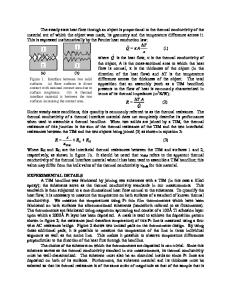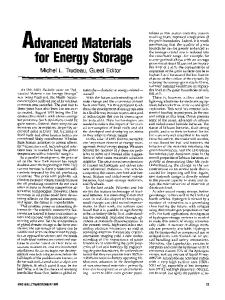Advanced Thermal Interface Materials
- PDF / 158,636 Bytes
- 6 Pages / 612 x 792 pts (letter) Page_size
- 25 Downloads / 404 Views
0968-V05-10
Advanced Thermal Interface Materials Yimin Zhang, Allison Xiao, and Jeff McVey Corporate Technology Group, National Starch and Chemical Company, 10 Finderne Avenue, Bridgewater, NJ, 08807
INTRODUCTION Thermal interface materials (TIMs) are widely used in electronic cooling. In a conventional filled polymer system, conductive fillers are uniformly dispersed in a liquid medium to form a paste. The paste can be optionally crosslinked, depending on the extent of crosslinking, to form a gel, a pad, or an adhesive. Pressure-sensitive-adhesives can be laminated on the TIMs to form a tape. The conductive fillers typically have a thermal conductivity of 50300 W/mK, whereas the matrix materials have much lower conductivity, typically in the range from 0.1 to 0.3 W/mK. Despite the relatively high conductivity of the fillers, the composite materials often have low conductivity values close to the resin, typically in the range of 1-5 W/mK. The primary reason for the low thermal conductivity of the composite is the thermal resistance at the interfaces of filler-filler and filler-substrate along the direction of heat flow. It is imperative to minimize the total resistance at filler-filler and filler-substrate interfaces for improved thermal conductivity. This may be achieved by orienting large-aspect-ratio fillers and/or by fusing the fillers. The fusible fillers can be metallic particles with melting point in the range of 50-250 °C [1-10], or small fillers (submicron or smaller), the surface layer of which may melt at temperature well below the bulk melting temperature [11-13]. In this study, we studied the effect of metal or alloy powders with low melting temperature. The low melting point materials can be of a foil or powders, which melt and fuse during temperature change and/or compression processes. However, there are limitations in these methods: many reported that a fluxing agent has to be used [1-4]; some cases require fillers to have a particular morphology [5] or size [6]; some systems require a particular group of resin [710]. In this study, we developed a universal method to enhance thermal conductivity of the composite, where the fillers can be of spherical or flake morphology, and fluxing agent is not required in the formulation. The composite can be of a variety of forms, such as a flim/pad, a get, a paste, or an adhesive. We also investigated the limitations of this technology, especially the particle volume fraction, morphology, and processing conditions. EXPERIMENT The characteristics of the conductive particles and are listed in Table 1. Bisphenol A diglycidyl ether was selected as the matrix material if not otherwise specified. The commercial resin blend was provided by Ablestik Laboratories. The conductive particles and matrix materials are weighted and blended with a 3-roll mill or a dual-axis centrifugal mixer before cured at elevated temperature. It is important to use low mixing speed to ensure the temperature of the formulation does not exceed the melting point of the alloy powders. Thermal
Data Loading...










